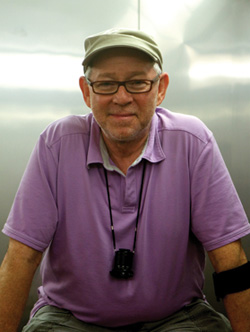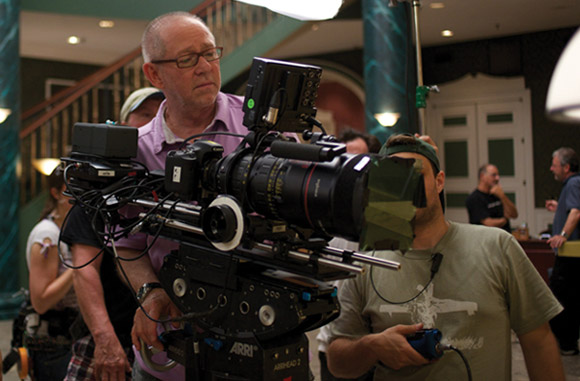
Photo: lan Markfield, C&A Productions, Inc.
Steven Poster’s career epiphany arrived in a vintage Jaguar, in the form of a pipe-smoking, bearded stranger who emerged from behind the wheel to survey the vacant lot next to Poster’s boyhood home. Hanging from a cord around the driver’s neck was an object the 14-year-old amateur photographer instantly recognized: a light meter. Already inspired by photography, home movies, and the technology behind them, Poster knew then what he wanted to be when he grew up.
“Morrie Bleckman was the coolest guy I had ever seen,” says Poster, about the newsreel cameraman for CBS Broadcasting, Inc., who was building a house on the property in Lincolnwood, Ill., and would become a lifelong mentor. “The moment I met him and found out what he did, I decided that I wanted to be a cinematographer.”
Today, Poster (DSGN ’67) has a reputation for being a skillful technologist with a repertoire of cross-genre film work to his credit. He has partnered with such directors as Ridley Scott (Someone to Watch Over Me), Richard Kelly (Donnie Darko), and Rob Minkoff, with whom he recently collaborated on the film Flypaper starring Patrick Dempsey.
During his final year at IIT Institute of Design, Poster began working first as an assistant and then quickly was asked to shoot commercials. He also had the opportunity to work with Herschel Gordon Lewis—the creator of “gore” films—who was based in the Windy City. Poster had one of his first Hollywood experiences when he served as second-unit cameraman for Close Encounters of the Third Kind.
A member of the American Society of Cinematographers, Poster is national president of the International Cinematographers Guild and is considered to be an industry spokesman for the changes in technology in the film industry. With the rise of digital and 3-D cinematography, Poster has mandated that guild members be trained to meet the industry’s needs. In 2009, the guild held 27 education programs in various technologies with the most popular this year being a course in 3-D techniques offered in conjunction with the Sony Corporation.
Poster says a one-size-fits-all approach is not part of the formula for creating the next Hollywood blockbuster. Flypaper is being shot digitally while this summer’s action-filled Cats and Dogs: The Revenge of Kitty Galore, which Poster worked on with director Brad Peyton, was shot in 35mm film but converted into 3-D.
“It’s complex and cumbersome to shoot in 3-D; it’s very technologically difficult,” he says. “It’s so difficult that none of us felt that the animals would respond well to that approach. The computer animation of the faces of the cats and dogs is just tremendous, however. The technology, in just 10 years, has come so far. It’s remarkable.”
High-Tech Cinematography

Photo: lan Markfield, C&A Productions, Inc.
Steven Poster has been influential in the use of digital technology for the motion picture industry for more than two decades. In 1990, he was selected to perform a test shoot with one of the first High-Definition television systems for Japan’s NHK Television. Poster describes his selections for the top technological advances in cinematography in the past decade:
Improved film emulsions
“The quality and sensitivity has increased 1,000-fold over the past 10–15 years,” says Poster, noting that as a result of these improvements, more
efficient digital technology has developed to reproduce high-quality motion picture images.
Development of single-chip image-gathering technology
Poster says that until recently, the only way a color movie image could be made electronically was through the use of multiple chips, or light sensors, that were designated to represent red, blue, and green light, resulting in a color image when combined through a prism. “With new image-gathering technology that captures the full spectrum on a single chip, digital images can represent the high-quality images we are used to seeing on film,” he says.
Post-production enhancements
Poster says that the ability to both laser-scan images from film and run digital files through a color-correcting system is significant. “Almost every element of every single frame can now be manipulated,” he adds. “This allows us as cinematographers to complete our art, as if we were going into a darkroom with a black-and-white enlarger and making a print. The Holy Grail that hasn’t been achieved yet is end-to-end, device-independent color management like the printing industry has had for years, so that what you see is really what you get on the screen.”
More Online
International Cinematographers Guild: www.cameraguild.com
American Society of Cinematographers: www.theasc.com